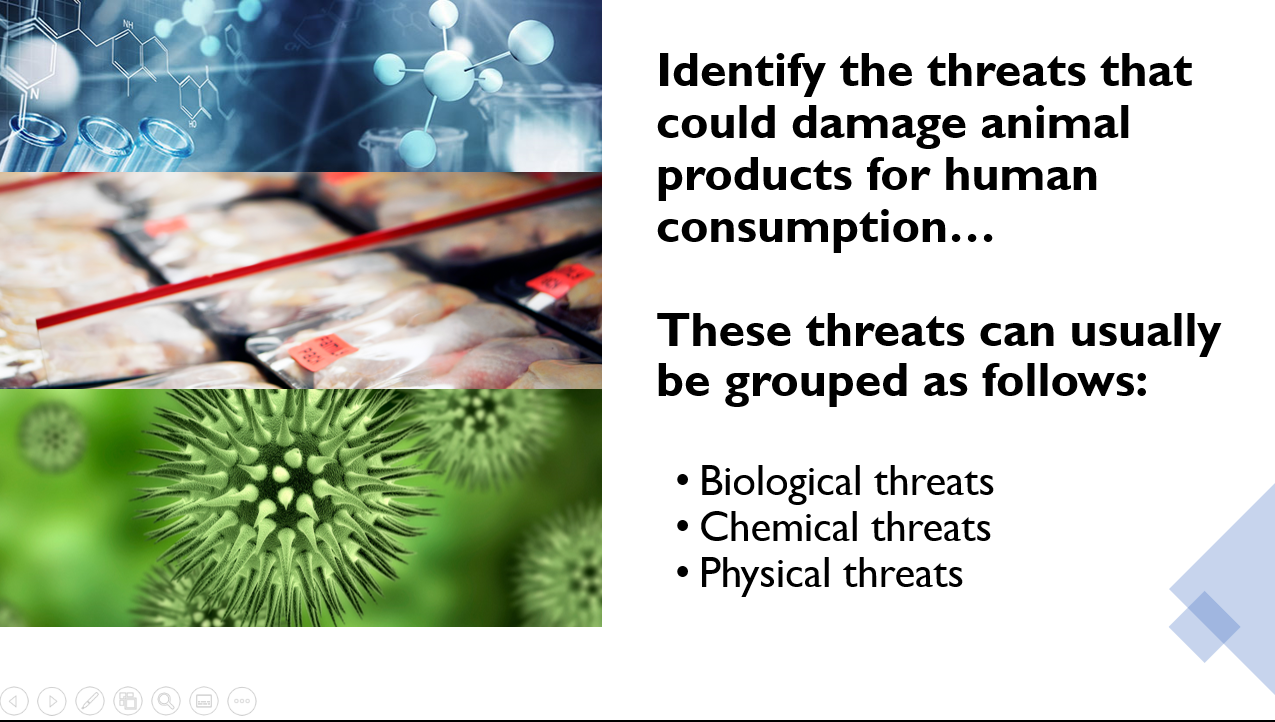All food manufacturers have a responsibility to ensure that quality assurance systems are in place to provide the final consumer with a product that is safe and wholesome to eat (Axtell and Fellows, 2003). As a supervisor or manager in a production unit or processing plant, it is your responsibility to ensure that the product leaving your facility is of the highest quality to be able to satisfy the discerning demands of the consumer. Any breach in quality will have serious consequences for your establishment. These consequences may include: loss of sales, loss of customers, cost of product recalls, and costs of wasted transport costs, lawsuits or fines. Thus, quality control and continuous and dedicated attention to all aspects of product quality should be a matter that is discussed with superiors daily.
Evaluate the Quality of Animal Product
The impact of various procedures, systems and methodologies on the quality of animal products is evaluated.
Quality control includes a wide range of and scope of activities to be carried out regularly. The ultimate task of quality control is to provide you, who are responsible for quality, with information such as the areas of highest risk, the source of a likely hazard, the quality criteria and standards that should be maintained, and methods to prevent the hazard from reducing this quality objective.

Early warning about failures and inability to meet quality standards at any stage of the production or value-adding process will help you to correct the situation in time and decrease losses caused by irrelevant quality of the product.
The best way to manage the quality of products is to establish a system wherein you can monitor and control hazards. The concept is to ensure the most efficient and effective sanitary control. Systems were designed to prevent problems by making sure controls are applied at any point in food production systems where critical situations could occur. These systems included TQM, QES, EUREGAP, HACCP, etc. First of all, you should identify the threats that could damage animal products for human consumption.
These threats can usually be grouped as follows:

Biological Threats
Living organisms that make products unsafe for consumption. It can be introduced during processing by people involved in processing, from the environment in which processing occurs or from other ingredients in the product.
Chemical Threats
- Occurs naturally in products.
- Added during processing.
- Added to food during growth, harvesting, storage, processing, etc.
Physical Threats
- Foreign material (a piece of equipment).
- Contaminated raw materials.
- Poorly designed facilities and equipment.
- Contaminated packaging.
After you had identified the threats you need to find the control points:
- You should find points in the process where preventive measures could be applied.
- Some points where control can be applied include:
- Inspections for contamination before shearing/slaughter
- Chilling to temperatures that minimise microbial growth
- Slaughter procedures
- Processing procedures
After you had identified these critical points, you need to find ways to control and maintain these points.
How to Monitor these Procedures
- Monitor that the procedure is carried out routinely and create a record for future use.
- Monitoring procedures include observations
- Make sure that the procedure is efficient and accurate
- Provide rapid feedback
To set up a quality control system for your production or processing facility a risk assessment should be carried out for each of the products that are produced (Axtell and Fellows, 2003). It should be remembered though that a manufacturer’s responsibility does not end when the product leaves the production unit. Poor control in the transport and retail chain can result in quality problems that may cause consumer complaints. In law, the food manufacturer may be able to claim that illness due to eating a product is the result of the retailer failing to keep the food at the correct temperature or the consumer using the product after its use-by date. However, any complaint will damage the name and image of the producer and may place the future of the enterprise at risk.
The following is a simple Risk Analysis for biltong (Biltong is considered a high-risk meat product because it is eaten raw without further cooking). Notice that the risk analysis goes beyond the manufacturer’s production unit.
|
Where Risk Occurs |
Hazard Sources |
Possible Actions |
|
In the production unit |
The greatest risk is cross-contamination from raw meat either by direct contact or by worker contact. Other risks include poor “first-in-first-out”) stock control and poor heat sealing of plastic packaging. |
Implement systems that ensure cross-contamination cannot occur. Check that all products are fully dried. Check heat seals. |
|
In the transport chain |
Poor handling can result in packaging being perforated and allowing moisture pick-up. Products transported with another hazardous material can become contaminated. |
Pack bags in strong, sealed cartons. Explain how you want the product transported. Use a reliable transport company even if a little more expensive. |
|
At the point of consumption where the biltong is placed in bowls on the bar as a snack |
Contamination due to flies or to people not washing their hands after using the toilet. The possibility that any biltong left over at the end of the day will be put out again the next day. |
Control solutions become difficult at this distance from production. However, provide advice by visiting your consumers and labelling your product. for example, suggest that proprietors only put small amounts in bowls to minimise customer contamination or provide individual snack plates to customers. |
The objectives of a Risk or Hazard Analysis, known as the hazard analysis and critical control point (HACCP) system, are to identify:
- Where the hazards occur.
- The nature of the hazards.
- Potential solutions to minimise risks that might damage the consumer or cause complaints.